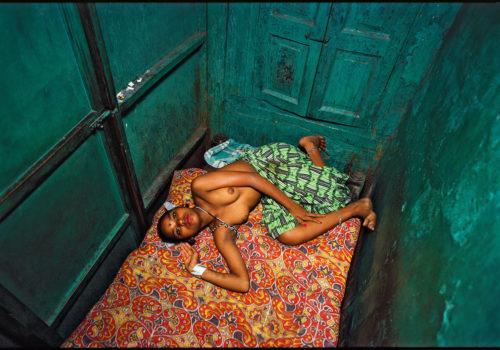Falkland Road was first published in 1981, with additional photos in a 2005 Steidl edition, and the book’s visceral images, together with an introduction and captions by the photographer, have made it one of Mary Ellen Mark’s seminal works. Now, a new edition has made use of improvements in the digital scanning of 35mm Kodachrome images and, with a revised sequencing, they can be seen at their very best. Mark took the photos in the late 1970s, sponsored by a magazine, but as she observed when working on the 2005 edition, a project like hers would no longer find this kind of support: ‘The only documentary photography we see is of war, disaster, and conflict. Most everything else has been replaced by fashion and celebrity photography’. Even the magazine that sent her to Mumbai (Bombay at the time) thought her photos too explicit for an American audience and it was their sister magazine in Germany, Stern, that published thirteen pages instead. (Mary Ellen Mark’s uncommon life as a photographer is memorably recorded by her husband in The Book of Everything.)
The saturated colour in the photographs acts as feverishly expressive of the aberrant state of affairs that is her subject matter. Although the effect is not dissimilar to some of John Divola’s work in Chroma, the methodology is very different. Divola used gels on his flash as a tool for his analytic methodology but Mary Ellen Mark eschews the artificial and abstract; unnatural colour in Falkland Road is part of her naturalistic approach to photography, on a par with the way Sabelo Mlangeni used black and white in Invisible Women to portray the cleaners who sweep the streets of Johannesburg at night. Mark and Mlangeni, sharing a concern with real-life experiences that remain a dark part of everyday life, both realized they couldn’t just turn up with their camera in the canonical documentary way. It would be an affront to what they were seeking to record. Mlangeni took eight months getting to know the street cleaners, sometimes sweeping alongside them with his camera left at home, and Mark spent ten years trying to overcome hostility and aggression from the women she wanted to photograph. In Falkland Road’s introduction, she describes how she gradually gained the trust of some prostitutes and provides essential background information to her project.
Make no mistake, the photographs are shocking – witness the frontispiece of a twelve-year old prostitute – and they are testimony to the obscene underbelly of male privilege that galvanized the #MeToo movement. They exist as part of a monetized exchange economy that trades the libidinal for cash. The women’s immiseration is absolute but so too is their interdependence. Their bodies become commodities in a free market but, unless working alone on the street, they live together in brothels and form a social and intimate existence that brings them unusually close to their employer, the madam. This triangulation of the economic, the libidinal and the socialized is the synchrony that animates existence in and around Mumbai’s Falkland Road.
Sean Sheehan
Falkland Road. Prostitutes of Bombay, by Mary Ellen Mark, is published by Steidl.
















